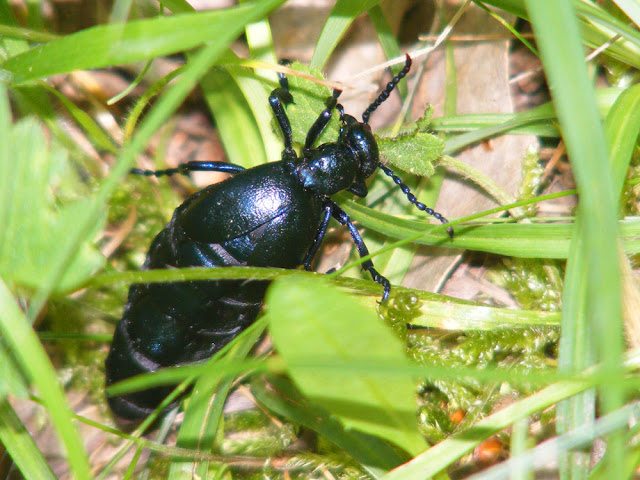Scientific Name: Meloe violaceus (Meloidae).
English Name: Violet Oil Beetle.
French Name: Le Méloé violet (='violet oil beetle').
5 Key Characters:
- black with purple, blue or green irridescence.
- enlarged abdomen which extends well beyond the tips of the wing cases.
- females (30 mm) much larger than males (10 mm).
- male antennae very kinked, females less kinked.
- thorax finely pitted, lower edge of thorax is obviously indented or curved, not straight, with a depressed area at the base and a large tooth.
Lookalikes: Black Oil Beetle M. proscarabaeus, which is usually more mat black, has coarser thoracic pitting and the thorax is almost straight across lower edge.
Habitat: Woodland edges, glades and rides, flower rich grassland, where they eat plants like Lesser Celandine Ranunculus ficaria, Dandelion Taraxacum spp, Cleavers Galium aparine and grasses. The larvae, called triungulins, are parasites of mining bees (ie they enter the bees' nests and eat the pollen the bees have collected and stored for their own larvae).
Adult Active Period: March-April-May-June-July. Adults are toxic and can exude a red liquid containing cantharidine (the dangerous active ingredient in Spanish fly) if distressed.
Status: The presence of Violet Oil Beetles indicates a robust population of mining bees and high quality flower rich grassland. The beetles are in decline because flower rich grassland is in decline, destroyed by agricultural intensification, development and changes in land use. The solitary bees who are essential for the survival of the triungulins are also in decline. Violet Oil Beetles make a very good indicator species for the health of their environment, and focusing on maintaining and creating flower rich grassland will benefit the beetles and their host bees.
Further reading and references: Buglife Oil Beetle Species Management Sheet.
Photographed by Loire Valley Nature:







No comments:
Post a Comment